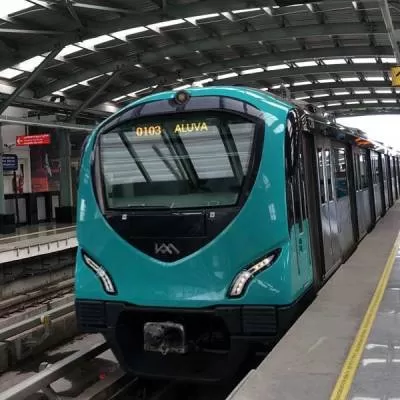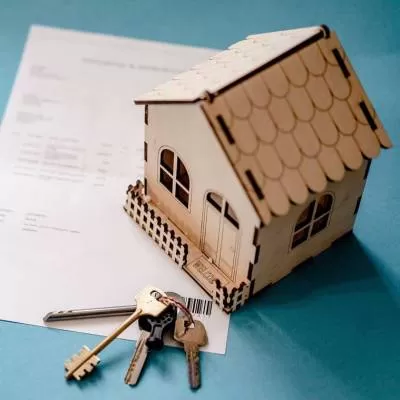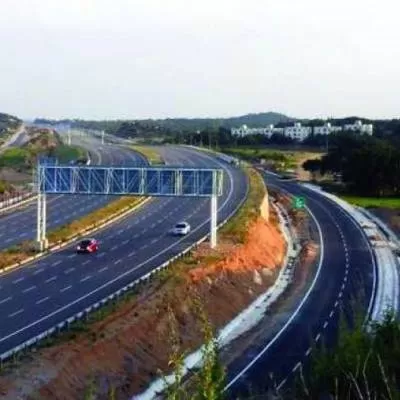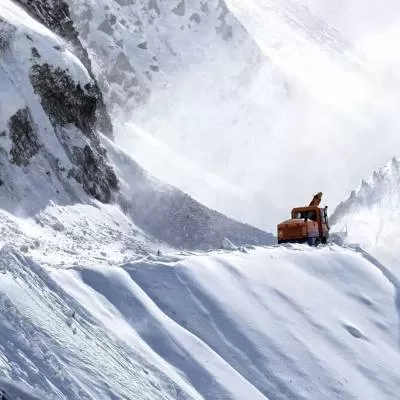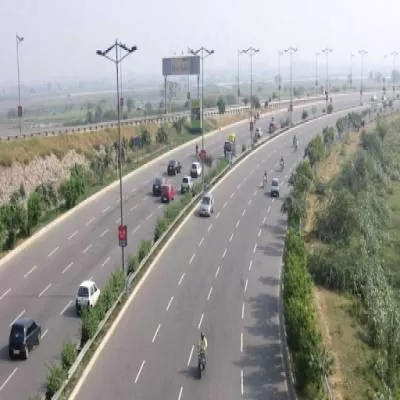- Home
- Infrastructure Transport
- ROADS & HIGHWAYS
- Crusader for Connectivity
Crusader for Connectivity
In the third of a series of interviews with prominent engineers, Janaki Krishnamoorthi meets Dhananjay Dhawad, Secretary (Roads), Public Works Department, Government of Maharashtra.
A good road network is the key to the economic development of an area,” asserts Dhananjay Dhawad, Secretary (Roads), Public Works Department, Government of Maharashtra. “I have seen in rural areas how good road connectivity has led to improved transportation, faster economic activities and enhanced agricultural practices. And in areas without good roads, providing even basic amenities becomes difficult and residents face several hardships.” No one knows this better than Dhawad, who hails from Harankhuri, a small village near Katol taluka in Maharashtra. “We had to walk around
5 km to reach Katol for everything, from the market to bus facilities that were available only here,” he recalls. “The bullock cart was the only other mode of transport.”
Little wonder then, that establishing connectivity through roads, bridges and highways has been his passion and profession for over three decades. A civil engineer from Government College of Engineering, Amravati, Dhawad, apart from a short stint in the private sector and teaching, has stayed in government service all along; just like his father and father-in-law. “The mindset in rural areas is inclined towards government service, perhaps because we are more exposed to government officers and administration. And for me, working for the government also means serving the public,” avers Dhawad, who has been involved in the construction of several major bridges and government buildings, and strengthening of roads and highways all over Maharashtra.
Water and energy conservation are also close to his heart. Apart from designing and constructing some green government buildings, he also designed and developed a structure for arresting surface water in rivers and nallas called Jal Bandh, which is being used by the Maharashtra Government in several rural areas. In fact, in 2004 Dhawad was invited by the University Science Malaysia to present a paper on Jal Bandh at an international conference in Penang on managing rivers in the 21st century.
Now engrossed in policymaking and administrative responsibilities, Dhawad misses the thrill and excitement of constructing buildings, bridges and roads. Today, he has to be content with conceiving and approving proposals for such projects, particularly those related to state highways and mega district roads that fall under his purview. But here too, he has found something stimulating to work on: a proposal to develop a world-class road network that will link Maharashtra from one end to another. “As I will retire in another two years, I may not implement the project but I hope to get the proposal completed and approved by the government,” avows Dhawad, as he shares details of his pet project as well as his views and experiences on a variety of issues with CW….
Pet project
This road network will run across Maharashtra covering the entire length and breadth of the state and anyone travelling within the state on secondary roads will be able to join the grid at some point and move faster. This grid will form part of the State Highway Development Programme (SHDP) and will be built on a par with international standards with hotels, food courts, malls, vehicle repair and fuelling facilities, etc. It will provide fast-track connectivity to the hinterland and help accelerate the socioeconomic development of these areas. The project cost will range between Rs 20,000 and Rs 30,000 crore.
Ailing Indian roads
I wouldn’t say our roads are bad but we do lag behind in quality compared to international roads. There are several reasons. First, in the past five decades we have not constructed many new roads but have only been developing existing ones; that too secondary and tertiary roads. We have not constructed a complete road network anywhere. Road construction was a low-key area until a decade ago as the government had several other priorities. Contribution to the road sector in the Centre or state plan used to be hardly 1-1.5 per cent of the total budget, sometimes going up to a maximum of 5 per cent. Generally, in countries like America, roads are built first and then settlements are brought in. But in our country it has happened the other way round, which makes road construction even more difficult and costly. Construction of roads in a scientific and systematic manner began in India only a decade ago with the National Highway Development Programme (NHDP). This requires huge funds. For instance, our national highways with four lanes are being developed at a cost of Rs 10 crore per km.
The Indian Government levied cess of Re 1 per litre on petroleum and diesel and created a ring-fenced fund that is being used for the development of national highways and rural roads under the Pradhan Mantri Gram Sadak Yojana (PMGSY).
Scenario in Maharashtra
Though the allocation of funds for roads has increased in Maharashtra (it is now 5-10 per cent of the total budget), it is still not sufficient to meet our needs. While my requirement for the planned sector is around Rs 6,000 crore, I barely get Rs 2,000 crore. For maintenance, I require another Rs 6,000 crore but the allotment is only Rs 1,300 crore to Rs 1,500 crore. However, in the past decade, investment in roads has increased owing to private participation. Around Rs 12,000 crore worth of projects are being developed in Maharashtra under BOT and PPP models. About 2,000 km of roads have been completed and the balance 3,000 km is either in progress or in the pipeline.
Funds for infrastructure projects
The PPP model is an effective arrangement for implementing infrastructure projects and it is here to stay. When we try to raise money through levies or tolls, there is always a big hue and cry from the public and politicians. The public should realise that if they want quality they should be prepared to pay for it. If you want to eat in a good restaurant, you have to pay a higher price. Otherwise, you must make do with vada pav!
Portfolio:
● Construction of several bridges including Wardha, Kaundinyapur and Karatkheda, and four bridges across the Godavari.
● Widening of Pedhi, Pili and Purna bridges on Amravati-Achalpur road and utilising old structural steel for construction of new bridges at Kalamkhar, Bhankhed and Wawruli.
● Construction and large-scale strengthening of several roads including National Highways.
● Planning of Amravati City Integrated Road Development Project at a cost of Rs114 crore.
● Construction of Government College of Pharmacy, Amravati; Computer Science building for Engineering College of Amravati; RTO Building in Nagpur.
● Restoration of heritage buildings-collector’s office, Golf Club and PWD house in Nashik-with eco-friendly features like thermo-ventilators and skylights.
● Setting up and modernisation of quality control laboratories, computerisation of office and laboratory work in various places in Nagpur.
● Authoring a handbook on training Assistant Engineers, published by Government of Maharashtra. Available on mahapwd.com
Track record:
Dhananjay Vitthalrao Dhawad
● BE (Civil) from Government College of Engineering, Amravati.
● DBM (Diploma in Business Management), Nagpur University.
● MA in Public Administration, Nagpur University.
● Passed MPSC Engineering Services Examination standing first in Maharashtra, selected as Assistant Engineer Class I and joined PWD.
● Served in various capacities in diverse divisions of PWD and in different areas of Maharashtra, including Beed, Aurangabad, Amravati, Dharmabad, Akola, Nashik and Nagpur.
● Promoted as Chief Engineer and posted in Amravati.
● Appointed Secretary (Roads), PWD, Government of Maharashtra.
Challenging projects:
Project: Widening three river bridges
Location: Amravati-Achalpur road
Cost: Rs 70 lakh
Period of construction: 2001 to 2003
Background: On the Amravati-Achalpur road, there were three bridges constructed in 1883 by the British over rivers Pedhi, Purna and Pili that required widening. One was a masonry bridge and the other two were steel bridges. The government decided to construct new bridges in their place at an estimated cost of Rs 18 crore. But the project was kept in abeyance for want of funds.
“I realised the bridges were in good condition and would remain so for another 50 years,” reveals Dhawad. “So I wondered why they could not be widened without knocking them down, thus saving on land acquisition, cost of new construction and time. So I submitted a proposal for widening the bridges within a period of four months at a total cost of Rs 70 lakh to the government.” The funds were sanctioned.
Details: It was a balanced, cantilever kind of construction. In the masonry bridge the parapet walls were demolished and RCC slabs placed without any support from the riverbed. All supporting systems were erected at bridge level. A 32-mm steel bar was placed digging some channels in the bridge, then brackets were suspended from the bar and tightened. Along with it girders were laid and reinforcement done with concrete. In the two steel bridges, the existing top steel trusses were removed and new steel structures used for the deck portion - it was all done on the same foundation and piers. All three bridges were completed at the estimated cost and time.
Unique feature: What was remarkable was using the dismantled trusses from these bridges to construct three new bridges. The steel trusses, each weighing about 25 tonne, were cut into three pieces, transported to the other site, reconditioned, welded and used for constructing three totally new bridges in Kalamkhar, Bhankhed and Wawruli .While the foundation and substructure were new, the superstructure was erected with the old steel.
Challenges: Widening the three bridges without any support from the riverbed and that too within four months was a real challenge. Time was also a major constraint and more so when work was held up for some time as cranes capable of lifting the heavy trusses and girders were unavailable locally and had to be brought in from Bihar. “It was a wonderful project, more skilful than difficult,” recalls Dhawad. “I had to identify a proficient contractor. Apart from saving time and money, around Rs 18 crore, by widening the existing bridges that are going strong even today, I also salvaged the old trusses, which would have normally been disposed of as junk, and used them in the new bridges, which was unheard of then!” In 2003, Dhawad received an award with prize money of Rs 1 lakh from the Maharashtra Government for this feat.
Project: Construction of Government College of Pharmacy
Location: Amravati
Cost: Rs 4 crore
Period: 2004 to 2005
Details: The building, a one-plus-one structure, was based on solar passive architecture. The building orientation was done taking into consideration movement of sunlight, wind, ambient temperature and humidity, and designed to provide internal comfort with less consumption of conventional fuel. “In a conventional building, the power load would have been 130 kw at any time,” explains Dhawad. “With this design, I managed to bring down the load to 80 kw, placing the building under low-tension consumption. I could prove that with this saving, we would be able to recover the cost of the construction in 15 years.” A rainwater harvesting system was also installed where rainwater from the roof was collected in a 3 lakh litre capacity water tank and the balance water diverted to a tube well.
Challenge: As this kind of design was being adopted for the first time in a government building, breaking mental barriers and persuading everyone concerned to accept the design was the biggest challenge. Dhawad received an award from the Maharashtra Energy Development Agency for this project in 2007.
- Construction
- Update
- Portal
- Magazine
- World
- 2010
- November
- India
- Dhananjay Dhawad
- Public
- Works
- Department
- Maharashtra
- Government
- Road
- economic
- transportation
- Harankhuri
- Katol
- Amravati
- Jal Bandh
- Malaysia
- Penang
- SHDP
- NHDP
- PMGSY
- BOT
- PPP
- Nagpur
- RTO
- Achalpur
- River
- Bridges
- Kalamkhar
- Bhankhed
- Wawruli
- RCC
- Pharmacy
- College
In the third of a series of interviews with prominent engineers, Janaki Krishnamoorthi meets Dhananjay Dhawad, Secretary (Roads), Public Works Department, Government of Maharashtra. A good road network is the key to the economic development of an area,” asserts Dhananjay Dhawad, Secretary (Roads), Public Works Department, Government of Maharashtra. “I have seen in rural areas how good road connectivity has led to improved transportation, faster economic activities and enhanced agricultural practices. And in areas without good roads, providing even basic amenities becomes difficult and residents face several hardships.” No one knows this better than Dhawad, who hails from Harankhuri, a small village near Katol taluka in Maharashtra. “We had to walk around 5 km to reach Katol for everything, from the market to bus facilities that were available only here,” he recalls. “The bullock cart was the only other mode of transport.” Little wonder then, that establishing connectivity through roads, bridges and highways has been his passion and profession for over three decades. A civil engineer from Government College of Engineering, Amravati, Dhawad, apart from a short stint in the private sector and teaching, has stayed in government service all along; just like his father and father-in-law. “The mindset in rural areas is inclined towards government service, perhaps because we are more exposed to government officers and administration. And for me, working for the government also means serving the public,” avers Dhawad, who has been involved in the construction of several major bridges and government buildings, and strengthening of roads and highways all over Maharashtra. Water and energy conservation are also close to his heart. Apart from designing and constructing some green government buildings, he also designed and developed a structure for arresting surface water in rivers and nallas called Jal Bandh, which is being used by the Maharashtra Government in several rural areas. In fact, in 2004 Dhawad was invited by the University Science Malaysia to present a paper on Jal Bandh at an international conference in Penang on managing rivers in the 21st century. Now engrossed in policymaking and administrative responsibilities, Dhawad misses the thrill and excitement of constructing buildings, bridges and roads. Today, he has to be content with conceiving and approving proposals for such projects, particularly those related to state highways and mega district roads that fall under his purview. But here too, he has found something stimulating to work on: a proposal to develop a world-class road network that will link Maharashtra from one end to another. “As I will retire in another two years, I may not implement the project but I hope to get the proposal completed and approved by the government,” avows Dhawad, as he shares details of his pet project as well as his views and experiences on a variety of issues with CW…. Pet project This road network will run across Maharashtra covering the entire length and breadth of the state and anyone travelling within the state on secondary roads will be able to join the grid at some point and move faster. This grid will form part of the State Highway Development Programme (SHDP) and will be built on a par with international standards with hotels, food courts, malls, vehicle repair and fuelling facilities, etc. It will provide fast-track connectivity to the hinterland and help accelerate the socioeconomic development of these areas. The project cost will range between Rs 20,000 and Rs 30,000 crore. Ailing Indian roads I wouldn’t say our roads are bad but we do lag behind in quality compared to international roads. There are several reasons. First, in the past five decades we have not constructed many new roads but have only been developing existing ones; that too secondary and tertiary roads. We have not constructed a complete road network anywhere. Road construction was a low-key area until a decade ago as the government had several other priorities. Contribution to the road sector in the Centre or state plan used to be hardly 1-1.5 per cent of the total budget, sometimes going up to a maximum of 5 per cent. Generally, in countries like America, roads are built first and then settlements are brought in. But in our country it has happened the other way round, which makes road construction even more difficult and costly. Construction of roads in a scientific and systematic manner began in India only a decade ago with the National Highway Development Programme (NHDP). This requires huge funds. For instance, our national highways with four lanes are being developed at a cost of Rs 10 crore per km. The Indian Government levied cess of Re 1 per litre on petroleum and diesel and created a ring-fenced fund that is being used for the development of national highways and rural roads under the Pradhan Mantri Gram Sadak Yojana (PMGSY). Scenario in Maharashtra Though the allocation of funds for roads has increased in Maharashtra (it is now 5-10 per cent of the total budget), it is still not sufficient to meet our needs. While my requirement for the planned sector is around Rs 6,000 crore, I barely get Rs 2,000 crore. For maintenance, I require another Rs 6,000 crore but the allotment is only Rs 1,300 crore to Rs 1,500 crore. However, in the past decade, investment in roads has increased owing to private participation. Around Rs 12,000 crore worth of projects are being developed in Maharashtra under BOT and PPP models. About 2,000 km of roads have been completed and the balance 3,000 km is either in progress or in the pipeline. Funds for infrastructure projects The PPP model is an effective arrangement for implementing infrastructure projects and it is here to stay. When we try to raise money through levies or tolls, there is always a big hue and cry from the public and politicians. The public should realise that if they want quality they should be prepared to pay for it. If you want to eat in a good restaurant, you have to pay a higher price. Otherwise, you must make do with vada pav! Portfolio: ● Construction of several bridges including Wardha, Kaundinyapur and Karatkheda, and four bridges across the Godavari.● Widening of Pedhi, Pili and Purna bridges on Amravati-Achalpur road and utilising old structural steel for construction of new bridges at Kalamkhar, Bhankhed and Wawruli.● Construction and large-scale strengthening of several roads including National Highways.● Planning of Amravati City Integrated Road Development Project at a cost of Rs114 crore.● Construction of Government College of Pharmacy, Amravati; Computer Science building for Engineering College of Amravati; RTO Building in Nagpur.● Restoration of heritage buildings-collector’s office, Golf Club and PWD house in Nashik-with eco-friendly features like thermo-ventilators and skylights.● Setting up and modernisation of quality control laboratories, computerisation of office and laboratory work in various places in Nagpur.● Authoring a handbook on training Assistant Engineers, published by Government of Maharashtra. Available on mahapwd.com Track record: Dhananjay Vitthalrao Dhawad ● BE (Civil) from Government College of Engineering, Amravati.● DBM (Diploma in Business Management), Nagpur University.● MA in Public Administration, Nagpur University.● Passed MPSC Engineering Services Examination standing first in Maharashtra, selected as Assistant Engineer Class I and joined PWD.● Served in various capacities in diverse divisions of PWD and in different areas of Maharashtra, including Beed, Aurangabad, Amravati, Dharmabad, Akola, Nashik and Nagpur.● Promoted as Chief Engineer and posted in Amravati.● Appointed Secretary (Roads), PWD, Government of Maharashtra. Challenging projects: Project: Widening three river bridges Location: Amravati-Achalpur roadCost: Rs 70 lakhPeriod of construction: 2001 to 2003Background: On the Amravati-Achalpur road, there were three bridges constructed in 1883 by the British over rivers Pedhi, Purna and Pili that required widening. One was a masonry bridge and the other two were steel bridges. The government decided to construct new bridges in their place at an estimated cost of Rs 18 crore. But the project was kept in abeyance for want of funds.“I realised the bridges were in good condition and would remain so for another 50 years,” reveals Dhawad. “So I wondered why they could not be widened without knocking them down, thus saving on land acquisition, cost of new construction and time. So I submitted a proposal for widening the bridges within a period of four months at a total cost of Rs 70 lakh to the government.” The funds were sanctioned.Details: It was a balanced, cantilever kind of construction. In the masonry bridge the parapet walls were demolished and RCC slabs placed without any support from the riverbed. All supporting systems were erected at bridge level. A 32-mm steel bar was placed digging some channels in the bridge, then brackets were suspended from the bar and tightened. Along with it girders were laid and reinforcement done with concrete. In the two steel bridges, the existing top steel trusses were removed and new steel structures used for the deck portion - it was all done on the same foundation and piers. All three bridges were completed at the estimated cost and time. Unique feature: What was remarkable was using the dismantled trusses from these bridges to construct three new bridges. The steel trusses, each weighing about 25 tonne, were cut into three pieces, transported to the other site, reconditioned, welded and used for constructing three totally new bridges in Kalamkhar, Bhankhed and Wawruli .While the foundation and substructure were new, the superstructure was erected with the old steel.Challenges: Widening the three bridges without any support from the riverbed and that too within four months was a real challenge. Time was also a major constraint and more so when work was held up for some time as cranes capable of lifting the heavy trusses and girders were unavailable locally and had to be brought in from Bihar. “It was a wonderful project, more skilful than difficult,” recalls Dhawad. “I had to identify a proficient contractor. Apart from saving time and money, around Rs 18 crore, by widening the existing bridges that are going strong even today, I also salvaged the old trusses, which would have normally been disposed of as junk, and used them in the new bridges, which was unheard of then!” In 2003, Dhawad received an award with prize money of Rs 1 lakh from the Maharashtra Government for this feat. Project: Construction of Government College of PharmacyLocation: Amravati Cost: Rs 4 crorePeriod: 2004 to 2005Details: The building, a one-plus-one structure, was based on solar passive architecture. The building orientation was done taking into consideration movement of sunlight, wind, ambient temperature and humidity, and designed to provide internal comfort with less consumption of conventional fuel. “In a conventional building, the power load would have been 130 kw at any time,” explains Dhawad. “With this design, I managed to bring down the load to 80 kw, placing the building under low-tension consumption. I could prove that with this saving, we would be able to recover the cost of the construction in 15 years.” A rainwater harvesting system was also installed where rainwater from the roof was collected in a 3 lakh litre capacity water tank and the balance water diverted to a tube well. Challenge: As this kind of design was being adopted for the first time in a government building, breaking mental barriers and persuading everyone concerned to accept the design was the biggest challenge. Dhawad received an award from the Maharashtra Energy Development Agency for this project in 2007.


